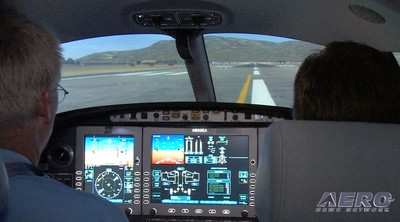FAA Support For The SAFE Symposium Was Significant... From The
Top Down
The following is a copy of the address given to the first SAFE
Pilot Training Reform Symposium this past week, by FAA Boss Randy
Babbitt:

Good afternoon, and thank you, Doug Stewart. I am delighted to
be here today with the movers and shakers of the flight training
community. Correction – I should say flight education
community – because the very name of this group –
Society of Aviation and Flight Educators – makes a point I
want to emphasize right off the bat.
We tend to use the words “training” and
“education” interchangeably, but they’re not.
Training is teaching someone how to do something. That’s
important, and when it comes to teaching pilots how to aviate in
terms of basic stick-and-rudder skills, training is an accurate
term.
But the trifecta of airmanship requires pilots to aviate,
navigate and communicate in the real world, and that’s where
education is so important. Education is about teaching a pilot how
to aviate no matter what, how to navigate challenges beyond the
textbook, how to communicate through crew resource management.
That’s what scenario-based training – or maybe I should
say scenario-based education – is all about.

Education helps develop professionalism. I have often wished I
could just mandate professionalism. We can make rules to require
certain professional behavior, but professionalism is a lot more
than rule-driven behaviors. It’s a mindset. To use flight
instructor terms – I can do that, because I was one –
professionalism requires application and correlation. It’s an
attitude that drives you to do the right thing – every time,
all the time, regardless of who’s watching. It’s about
being a good aviation citizen.
If that term is familiar, well, it’s because we heard it
from one of SAFE’s members, and we liked it so much that we
included it in the Aviation Instructor’s Handbook. An
aviation educator develops an aviation citizen – a
professional – not just by training to proficiency in
airplane control and aircraft systems but also by educating that
pilot to:
- Make safety the number one priority.
- Use good judgment in making decisions.
- Recognize and manage risk.
- And to be accountable.
Those ideas are also in the Flight Instructor’s Model Code
of Conduct, which was just released by a group of industry folks
who are passionate about professionalism. I am a real believer in
the value that a code of conduct can have as a tool to promote
safety, good judgment, ethical behavior, and personal
responsibility.

Another part of developing professionalism is mentoring –
a concept I have been on both sides of throughout my aviation
career. Mentoring is a transfer of experience. I learned a lot from
the pilots who mentored me in my career as a pilot, and I in turn
mentored my students when I was an instructor and my first officers
when I was an airline pilot.
SAFE’s members – who include at least a
decade’s worth of flight instructors of the year – are
highly accomplished people with a lot of valuable experience to
transfer. So let me congratulate you on starting the SAFE Aviation
Educator Mentoring Program. I especially like the program statement
that “Even experienced educators may occasionally want or
need insights when teaching in new aircraft, or with new
technologies and techniques.” None of us should ever stop
learning.

These initiatives show how all of you, who are on the front
lines – or maybe I should say the flight lines – in the
flight education community are making a difference – not just
today, not just tomorrow, but for the entire future of aviation.
You do more than talk about professionalism – you lead the
way by example. That’s what gives life and meaning to the
idea of safety culture, and it will make professionalism as natural
as breathing for the next generation of aviators.
So I’m very eager to have your help in developing the
FAA’s five-year strategy for transforming general aviation
safety. That strategy has four elements.
The first is risk management. Improving how pilots do risk
management is one of the most effective ways to reduce fatal
accidents. One new risk management tool is the advisory circular on
Airmen Transition to Experimental or Unfamiliar Airplanes.
It’s worth reading and even more importantly worth using.

The second area is training and education, with an expanded
focus on flight instructors. We are working with you in a couple of
key areas. One is updates to the advisory circular on Flight
Instructor Refresher Courses. Another is testing. We recognize that
the way the FAA does testing influences the way the industry does
education and training, so we have to get that piece right. We
appreciate your offer to form a steering committee of industry
leaders to help us with that process.
Part three of the GA transformation strategy is safety promotion
through the FAA Safety team. Partnership with industry is a key
part of the FAASTeam’s approach, and we are looking at some
innovative ways to enhance it. Stay tuned.
Last, but not least, is outreach and engagement with
organizations like SAFE, NAFI, AOPA, and EAA, plus type clubs,
manufacturers, insurance providers, academia, and anyone else who
has a role to play in GA safety and professionalism. We don’t
have all the answers. We need your help to reduce GA accidents.

Another area where we need your help is in supporting NextGen. I
know there is a perception that NextGen benefits only big
operators. The reality is that everyone in aviation stands to gain
from the NextGen.
First and foremost, NextGen makes safety sense – it is
already giving pilots a greater situational awareness in the
cockpit and that is critical for all of us.
NextGen bundles dozens of improvements in airports, avionics and
air traffic control. The entire NextGen effort will create a much
more efficient, responsive, “green” airspace system
that serves the public and supports our national economy.
It will take time to develop the full system, but I need your
help now. GA has long been on the cutting edge of technology. Many
of you were flying and instructing in aircraft with integrated
“glass cockpit” avionics as soon as they came out of
the factory, and I know this audience includes some of the people
who literally wrote the book on using it. Because of where you fly
and how you fly, you have been among the first to take advantage of
the WAAS-enabled GPS approaches we are establishing all over the
country – including at hundreds of smaller airports where we
could never justify the cost of installing and maintaining an
ILS.

So I am asking you to continue that tradition by helping us
expand and validate the benefits of NextGen. You and the pilots you
educate can do that by taking advantage of what is already
available – not just the WAAS-enabled approach procedures,
but also ADS-B. There are several major benefits.
First, ADS-B offers better surveillance in fringe areas of radar
coverage. Second, ADS-B does not have the siting limitations of
radar. Third, its accuracy is consistent throughout the range. And
here’s a big one: aircraft equipped with ADS-B can get
real-time traffic and flight information without a subscription
fee. Those services exist in many areas now, and will be available
almost everywhere we have radar services today by 2013.
I know that ADS-B equipage is an investment, and times are
tough. But this technology has already helped GA in Alaska and the
Gulf of Mexico. We hope pilots everywhere will take advantage of
it. So I ask that you use your influence as educators to help
pilots understand the benefits, and learn to use the technology for
enhanced safety. Because that’s what it’s all about
– educating pilots to be safe pilots and good aviation
citizens.

Thank you for inviting me and, above all, thank you for all you
are doing for professionalism in pilot education and training.
Aero-Note: In addition to the
address given, Babbitt took several questions from members of the
symposium. ANN will be presenting excerpts from the Administrator's
Q&A Session later this week.
 ANN's Daily Aero-Linx (04.16.24)
ANN's Daily Aero-Linx (04.16.24) Aero-News: Quote of the Day (04.16.24)
Aero-News: Quote of the Day (04.16.24) Airborne 04.10.24: SnF24!, A50 Heritage Reveal, HeliCycle!, Montaer MC-01
Airborne 04.10.24: SnF24!, A50 Heritage Reveal, HeliCycle!, Montaer MC-01 Airborne 04.12.24: SnF24!, G100UL Is Here, Holy Micro, Plane Tags
Airborne 04.12.24: SnF24!, G100UL Is Here, Holy Micro, Plane Tags Airborne-Flight Training 04.17.24: Feds Need Controllers, Spirit Delay, Redbird
Airborne-Flight Training 04.17.24: Feds Need Controllers, Spirit Delay, Redbird










